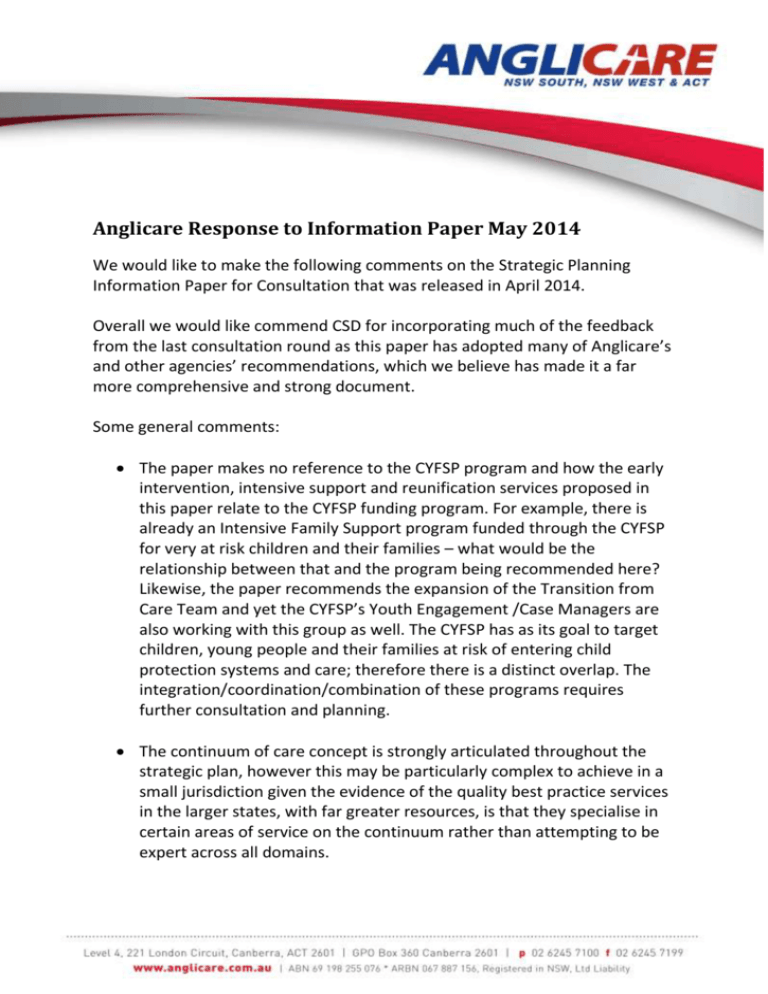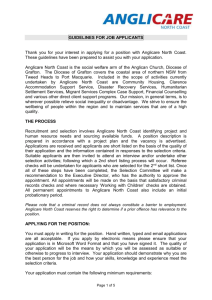Anglicare Response to Information Paper May 2014
advertisement

Anglicare Response to Information Paper May 2014 We would like to make the following comments on the Strategic Planning Information Paper for Consultation that was released in April 2014. Overall we would like commend CSD for incorporating much of the feedback from the last consultation round as this paper has adopted many of Anglicare’s and other agencies’ recommendations, which we believe has made it a far more comprehensive and strong document. Some general comments: The paper makes no reference to the CYFSP program and how the early intervention, intensive support and reunification services proposed in this paper relate to the CYFSP funding program. For example, there is already an Intensive Family Support program funded through the CYFSP for very at risk children and their families – what would be the relationship between that and the program being recommended here? Likewise, the paper recommends the expansion of the Transition from Care Team and yet the CYFSP’s Youth Engagement /Case Managers are also working with this group as well. The CYFSP has as its goal to target children, young people and their families at risk of entering child protection systems and care; therefore there is a distinct overlap. The integration/coordination/combination of these programs requires further consultation and planning. The continuum of care concept is strongly articulated throughout the strategic plan, however this may be particularly complex to achieve in a small jurisdiction given the evidence of the quality best practice services in the larger states, with far greater resources, is that they specialise in certain areas of service on the continuum rather than attempting to be expert across all domains. Of concern also is the continual inclusion of kinship care as a component of the continuum of care. It is clear in the strategic planning that kinship placement is the preferred plan for all children and young people entering care. Kinship care is an inherently complex and very different placement service than foster care/residential care services. As such it should be developed as a different program of care with a related continuum developed within a family focused framework rather than simply being added to the non family/ kin placement continuum. As such the continuum of care for kinship could include stronger and innovative placement planning options including intensive placement identification services, family care planning conferencing, extended family intensive support services and shared care family services. The PCIP is recommended as a comprehensive intervention program for parents and carers to assist them with the management of complex behavioural issues and improve the quality of the parent child relationship. It is unhelpful to focus on one particular program in a strategic planning paper of this type, particularly as this program only focuses on interventions with children aged 3-7 years. It would be preferable to specify the importance of funding programs that work on child-parent relationships with a trauma informed-attachment focus and including those that also intervene in the first three years. This will promote flexibility in the style and type of services offered to meet the diverse needs of vulnerable families. The focus on comprehensive therapeutic assessments is positive, however, unless there are the services to match the recommendations of the assessment this may fail. It will also set expectations for children, young people, their carers and case workers, that will not be able to be met. This strategy will require a cross government and sector review to maximise the capability and capacity of both sectors to meet this increased need for service. In the information sheet for Families there is mention of adoption as an option, but this is not referred in any detail in the strategy paper. It s very important that adoption be an option for some children. This is even more critical in light of the changes to the legislation and practice that is occurring across the border in NSW. While EPRs may be appropriate for some children, for others the move to permanency through adoption is vital and needs to be more clearly articulated as part of the continuum of care. In relation to carer recruitment and assessment it is unclear what is actually being proposed – is there to be an independent new service to perform this function? Or is it about more consistent practices across agencies? Further clarification of what is being considered would be useful. In relation to the Health Passport this needs buy in and commitment from ACT Health to support the health assessment and ongoing monitoring of children moving in and out of care. Overall there is no reference to the work of other government departments and the relation of the strategy to this. While the Human Services Blueprint may address this, in this paper it would be important to talk about the role of both Education and Health in making this strategy work. There is no mention of the links to other early childhood services, ie child care centres, playgroups etc. and the critical role these services can play in the early intervention and reunification stages for families. More specific mention should be made of the need to continue to fund and support at risk children to attend early childhood settings. In relation to professional carers – will they have to take all referrals to them or are they going to be able to pick and choose? The mandatory nature of their work will be important. There is little on the proposed model of accreditation and what this would look like – further detail would be useful to have to evidence the relative benefits of a Departmental accreditation process as described during the strategy paper presentation as compared with an independent review body model adopted in other states. In relation to financial incentives for agencies achieving outcomes – does this match with policy elsewhere in ACT government? As it is currently not in other funding programs across government, this may well cause difficulties by having it in one funding program and not another e.g. homelessness services. This can be a particularly complex process and is likely highly problematic to determine how agencies are assessed and rewarded. Training in therapeutic care also needs to extend to residential workers, particularly if there is an expectation that residential care services have a stronger therapeutic focus. In relation to information management consideration needs to be given to the proposed data collection system for the CYFSP program, as many of the clients in the out of home care system are also accessing CYFSP services. We would be happy to expand on any of the abovementioned points if required. Regards Jenny Kitchin Director of Community Services, ACT --------------------------------------------------------3/80 Beaurepaire Cresc. Holt ACT 2615 Telephone: (02) 6278 8403 Fax: (02) 6278 8499 E-mail: jenny.kitchin@anglicare.com.au Website: www.anglicare.com.au art text here.











